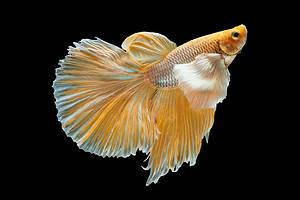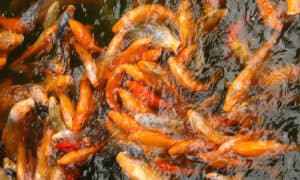With an inherent sense of curiosity, goldfish are natural explorers that infuse their vibrant energy and array of colors that make for a spectacular aquatic exhibition. Beyond their quirky nature, their enchanting exterior lies a treasure trove of qualities, making them masterpieces worthy of admiration. Join us as we explore the most expensive types of goldfish and reveal their mind-blowing prices.
Crown Pearlscale Goldfish (Cost $30-$100)
The Crown Pearlscale Goldfish is known for its distinctive head growth, enhanced with small shimmering pearl-like scales. This Goldfish comes in various colors, including red, orange, white, black, yellow, and even combinations of multiple shades. To maintain vibrant colors and prevent dullness, a protein-rich diet with pellets and fresh vegetables is necessary.
These fish thrive in a well-maintained aquarium equipped with suitable filtration and oxygenation systems. Regular water changes are essential to maintain water quality in their environment. Additionally, eliminate any sharp objects or rough surfaces that could pose a risk to their delicate scales.
Short-Tailed Ryukin Goldfish (Cost $20-$150)
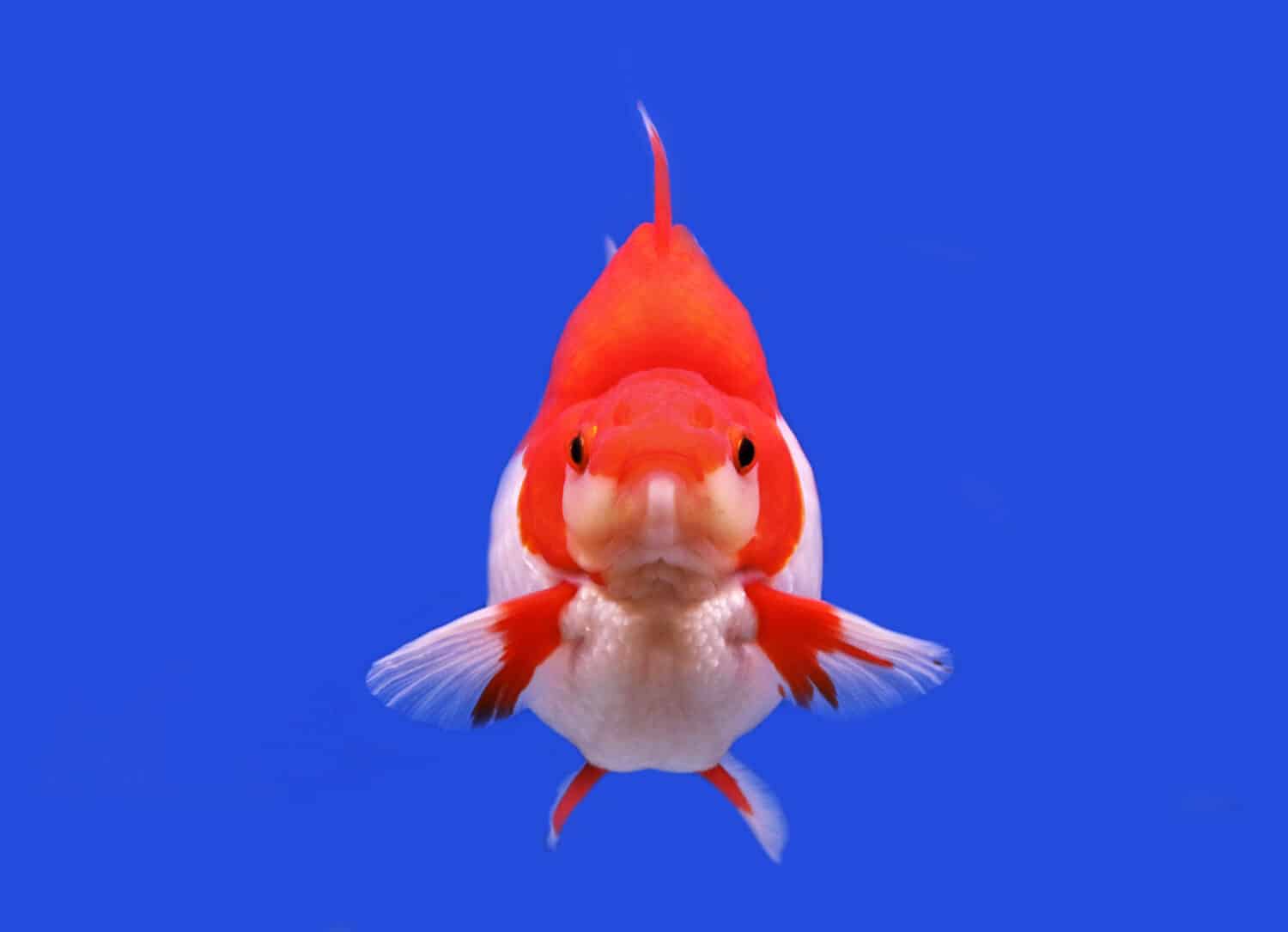
The Ryukin goldfish features double anal fins, a unique trait compared to other goldfish.
©Arunee Rodloy/Shutterstock.com
Ryukin goldfish, originating from Japan, are the result of crossbreeding Chinese Lionhead goldfish with Japanese Fantail goldfish. These unique fish are known for their distinctive traits, including a rounded body shape often compared to an egg. The Ryukin goldfish sets itself apart with double anal fins positioned closely together, a unique trait uncommon in most goldfish species with a single anal fin. In addition, these fish exhibit a wide range of colors, including solid shades such as red, orange, white, black, and metallic hues. Furthermore, its scales feature a popular calico pattern, showcasing striking red, orange, black, and white patches.
Regarding the diet of Ryukin goldfish, their main food source should be high-quality goldfish pellets or flakes. However, incorporating fresh vegetables like peas or lettuce into their meals can provide additional benefits. Additionally, for added variety and essential nutrients, it is advisable to occasionally include live or frozen foods such as bloodworms or brine shrimp in their diet.
Panda Moor Goldfish (Cost $50-$150)

The
Panda
Moor goldfish features a pearly shimmer and tri-color combination markings.
©hxdbzxy/Shutterstock.com
Originating from ancient China, the Panda moor goldfish showcases a streamlined body structure with a significant curvature reminiscent of a graceful swimming dragon. Some individuals feature an elongated caudal fin, while others display a butterfly-shaped tail. The scales of these Goldfish come in various metallic to matte hues, creating a pearly shimmer.
In addition to the typical metallic orange, red, and black coloration, Panda Moor Goldfish exhibit a range of speckled and tri-color combination markings. Unlike some other goldfish varieties, Pandmoors are known for their heightened sensitivity to water conditions, requiring pristine water quality with minimal levels of ammonia and nitrate.
Panda Oranda Goldfish (Cost $50-$200)
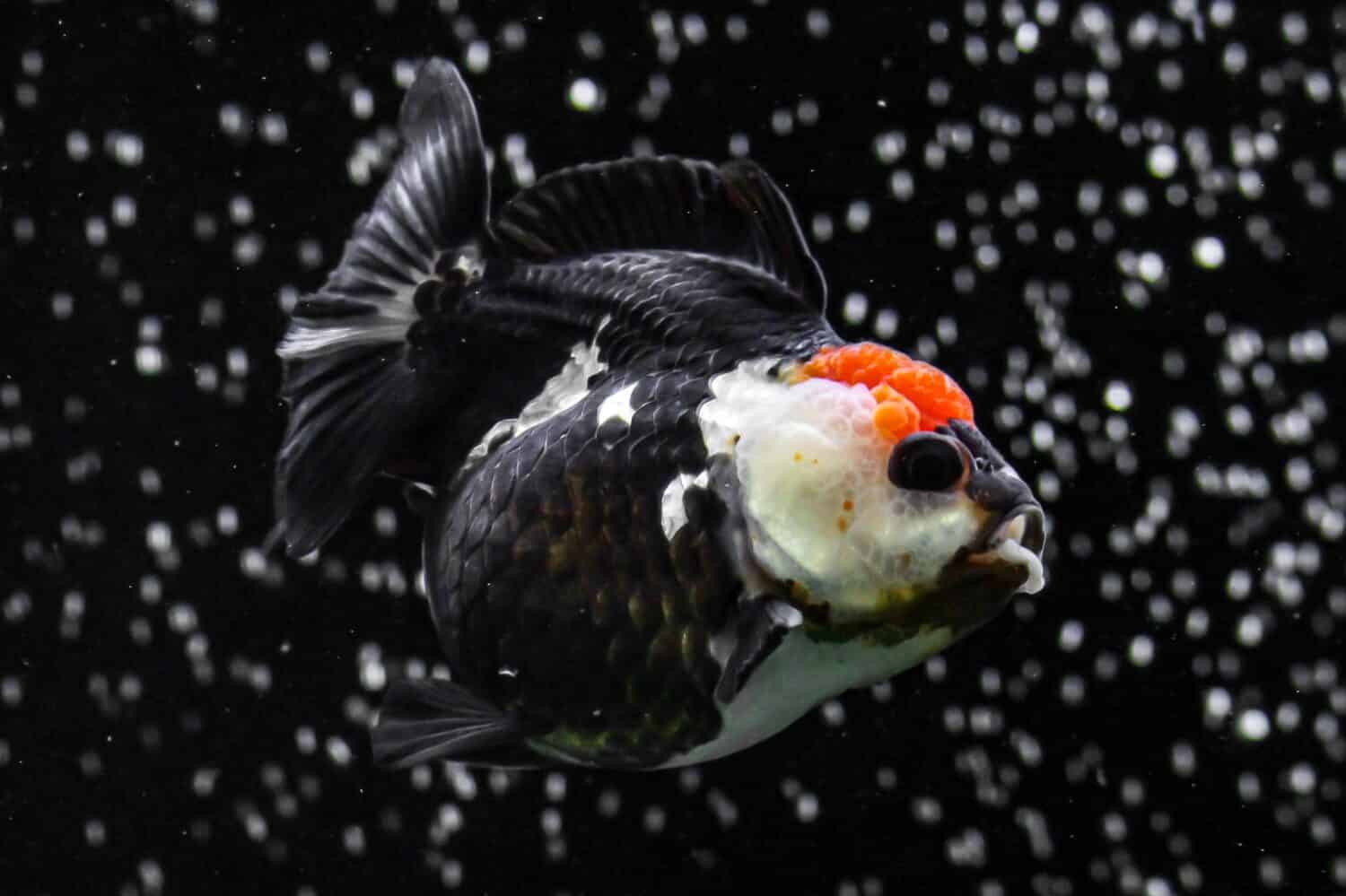
The Panda oranda goldfish gets its name from a similarity to the panda.
©Wisnu Bangun Saputro/Shutterstock.com
Originating in China through centuries of selective breeding, these exquisite Goldfish embody human ingenuity. With a predominantly white body adorned by scattered black patches on its scales, they represent a striking resemblance to the beloved panda.
The appeal of these creatures is further heightened by their playful nature and lively swimming patterns, making them a sheer joy to observe in an aquarium. Adding to its distinctiveness, the Panda Oranda goldfish stands out with its unique head growth, which becomes more prominent as the fish matures. However, despite their remarkable attributes, these fish face challenges maintaining buoyancy due to their delicate swim bladder.
Red Cap Oranda Goldfish (Cost $150)
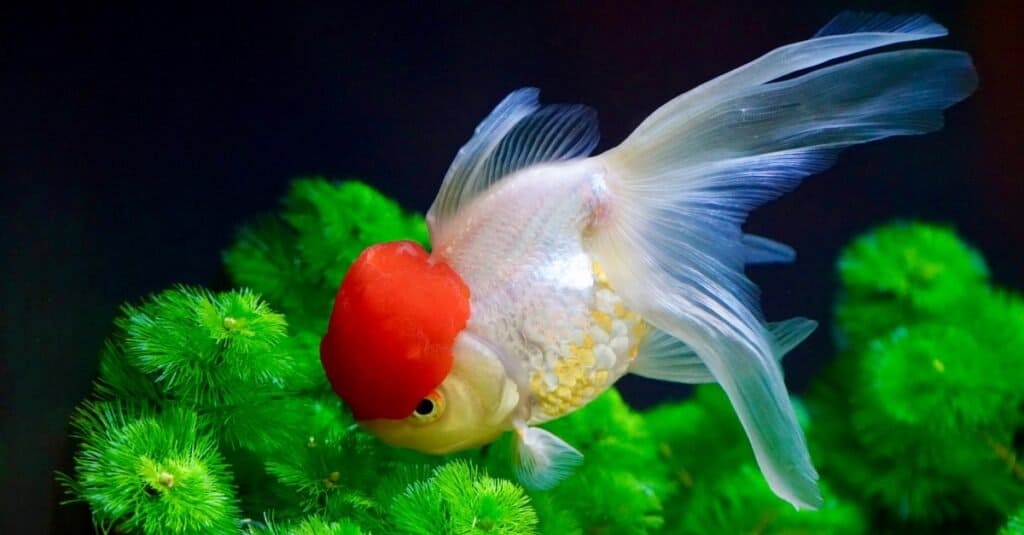
The Red Cap Oranda is one of the most expensive types of goldfish, prized for its high adaptability.
©Wang Sing/Shutterstock.com
The Red Cap Oranda goldfish features an orange-red growth located on the top of its head. Its wen complements its body, which displays its beautiful metallic white color. The Red Cap Oranda showcases a rounded body shape, complemented by a gently arched back and elegantly flowing fins. Renowned for their peaceful nature, they can harmoniously coexist with other Goldfish and community fish species. However, it is crucial to exercise caution when introducing them to potentially aggressive species, especially those known for targeting delicate fins.
The Red Cap Oranda goldfish’s hardiness contributes to its high favorability. It easily adapts to different water conditions, making it a low-maintenance species. With proper care and ideal water parameters, these fish can thrive for many years. Furthermore, they are known for their intelligence and ability to bond with their owners, creating an interactive pet experience.
Izumo Nankin Goldfish (Cost $150)
The Izumo Nankin Goldfish originates in Japan, particularly in Izumo, a region renowned for its cultural heritage and agricultural practices. In Japanese culture, this Goldfish holds great significance, symbolizing good luck, prosperity, and abundance. The Nankin color pattern, featuring vibrant shades of orange and red with patches of white or yellow, adds to its allure. Collectors and enthusiasts highly admire this unique pattern for its aesthetic appeal.
The Izumo Nankin Goldfish exhibits a plump appearance characterized by a rounded belly resulting from intentional breeding. This goldfish variety is showcased in exhibitions and competitions where judges meticulously assess their coloration, body structure, and overall appeal. These events are a tribute to the expertise and dedication of breeders who strive to produce the perfect specimen.
Celestial Eye Goldfish (Cost $20-200)

The wild eyes of the Celestial Eye make it a popular pet among goldfish afficiandos.
©Dan Olsen/Shutterstock.com
The Celestial Eye Goldfish is recognized for its peculiar appearance. With its lineage originating from the Telescope Goldfish, this breed displays its odd-looking protruding eyes uniquely positioned on the sides of its head. Another striking characteristic of the Celestial Eye Goldfish is its double tail which allows it to flow freely in the water. Additionally, this fish has a rounded physique, followed by various colors such as red, white, orange, and black.
Due to the unique orientation of their upward-facing eyes, Celestial Eye Goldfish are susceptible to gulping air at the water’s surface, potentially resulting in swim bladder problems. Moreover, their impaired vision poses challenges in finding food. To prevent this risk, offering them sinking pellets or flakes during feeding is recommended.
Chocolate Pompom Goldfish (Cost $75-$300)
The Chocolate Pom Pom Goldfish, which has its origins in China, is named after the cotton ball because of the growths on each side of its head. The development of pompom-like growth begins around 3 to 4 months of age. However, these growths become increasingly larger as the fish matures. The body of this fish boasts a chocolate brown color, while its pom poms come in vibrant shades of white, orange, or even red.
Regular water changes are imperative due to their tendency to produce more waste compared to other goldfish types. Additionally, it’s important to note that they can be more vulnerable to temperature fluctuations. In terms of their diet, they thrive on a combination of fish pellets or flakes, supplemented with occasional live or frozen treats such as bloodworms, brine shrimp, or daphnia.
Tosakin Goldfish (Cost $75-$500)

One of the most expensive goldfish is the Tosakin goldfish.
©Sad Agus/Shutterstock.com
The exquisite Tosakin goldfish, originating from 19th-century Japan, results from breeding techniques derived from the Ryukin goldfish lineage. The main goal in developing the Tosakin goldfish was to enhance its aesthetic appeal, resulting in a fan-shaped double tail and an arched back. As Tosakins mature, their tails can grow up to 8 inches in length
Breeding the Tosakin goldfish presents a significant challenge due to the intricacy of its tail formation. As a result, the inherent difficulty in breeding them contributes to the exclusivity and value of these exceptional Tosakin specimens. Tosakin goldfish breeds showcase a range of colors, including vibrant metallic shades of red, white, blue, and black.
Giant Thai Lionchu Goldfish (Cost $100-$500)

The Giant Thai Lionchu goldfish is a cross between the Lionhead and Ranchu goldfish.
©Anstey33/Shutterstock.com
Originating from Thailand, the Giant Thai Lionchu Goldfish combines traits of Lionhead and Ranchu goldfish varieties. Renowned for its majestic allure, this fish exhibits a robust body shape and a strikingly elevated dorsal fin. This Goldfish showcases a vibrant palette of colors, including reds, oranges, yellows, whites, blacks, and captivating calico patterns.
The Giant Thai Lionchu Goldfish have a distinctive wen on their heads, varying in size and shape from small to large, sometimes covering their entire face. This adds an extra dimension to their appearance, making them highly sought after by collectors for their easily identifiable looks. These fish require spacious aquariums or ponds equipped with dependable filtration systems to promote their well-being. Additionally, they have a preference for vegetable-based meals.
The photo featured at the top of this post is © Wisnu Bangun Saputro/Shutterstock.com
Thank you for reading! Have some feedback for us? Contact the AZ Animals editorial team.





